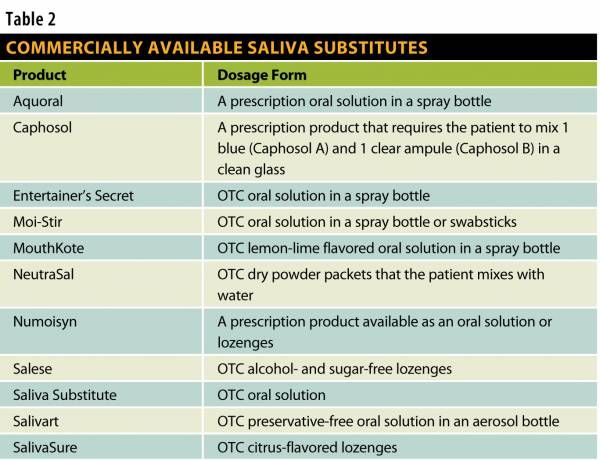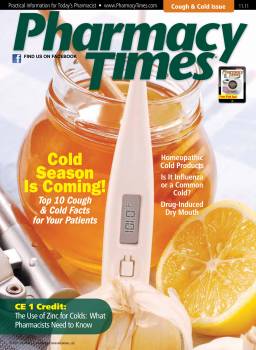Publication
Article
Pharmacy Times
Drug-Induced Dry Mouth
Author(s):
More than just an annoyance, xerostomia requires dilligent treatment to prevent a decline in health.
More than just an annoyance, xerostomia requires dilligent treatment to prevent a decline in health.
Dry mouth (xerostomia) can change speech patterns, allow dentures to rub, and contribute to dental caries. It also changes dietary preferences: who wants to eat peanut butter or saltines with a dry mouth? It may alter the sufferer’s nutritional status, causing vitamin deficiencies and caloric insufficiency—once salivary flow is reduced by half, chewing and swallowing become problematic.1 Dry mouth can change appearance, too; lipstick on the teeth is a clue that the wearer may have xerostomia.
Up to 30% of Americans experience xerostomia,2-8 with elders affected more.9 Many things cause a sticky, dry mouth— scary movies, dental cotton before a procedure, heredity, snoring, or mouthbreathing during a cold—but medication is the most frequent cause.10-12 Most medications associated with dry mouth affect the sympathetic nervous system, thickening and limiting the flow of saliva.13
Saliva
Three pints of saliva: that’s how much the average healthy person makes daily. It’s 99% water and 1% proteins, enzymes, and electrolytes.13-16 Saliva’s role is more complex than just moistening food as we chew. It contains the enzyme amylase which breaks down select starches into maltose and dextrin, initiates fat breakdown, and starts digestion.17 Saliva’s calcium and phosphate content restores those leached substances to tooth enamel. It also contains role-specific proteins (eg, antibacterial histatins, protective statherins, lubricating mucins).18 Right before a person vomits, the brain signals the salivary glands to increase saliva secretion. This decreases oral acidity, protecting the mucosa and teeth from acidic emesis.17 It has numerous other roles as well.
When dry mouth becomes chronic, dental health declines and patients may develop infection. Thrush (candida albicans) infection is common, especially in patients who wear dentures, smoke, take corticosteroids, or have diabetes.10,19,20 The loss of salivary proteins and electrolytes— which inhibit cariogenic microorganisms and buffer oral acids—accelerates tooth decay.10 Table 110,20-28 lists the nonpharmacologic causes of dry mouth.

Drugs and Dry Mouth
Several hundred medications can cause or exacerbate xerostomia,10-12 including antihypertensives, antidepressants, analgesics, tranquilizers, diuretics, and antihistamines. 29 These drugs affect the saliva’s quantity and possibly quality, but usually the problem is temporary or reversible. The chewing gum manufacturer Wm. Wrigley Jr. Company’s Web site—www .drymouth.info—provides a searchable list of drugs associated with dry mouth. Their explanation of the complexities of identifying drugs that cause dry mouth (see http://drymouth.info/practitioner/complexities.asp) highlights the inadequacies of our current adverse event, adverse effect, and side effect monitoring systems.
Treatment
For drug-induced xerostomia, using the lowest effective dose or switching to an alternative medication may help. If dry mouth is associated with correctable causes and correction of underlying causes doesn’t improve the condition, several additional steps are critical. Patients should see a dentist and have fluoride-containing sealants applied to seal pits, fissures, and rough restorative margins. The dentist may recommend a regular dose of fluoride and an antibacterial dental varnish containing 1% chlorhexidine and 1% thymol to prevent dental caries. Chewing xylitol gum enhances salivary flow and helps control mutans strep, but note that elders who wear dentures may be unable to chew gum. Patients should be encouraged to conduct a daily mouth examination, checking for red, white, or dark patches, ulcers, or tooth decay.30
Sipping water or sucking on ice chips throughout the day may moisturize the mucosa and possibly alleviate symptoms. If this is not effective, artificially moisturizing the mucosa is a possible next step. Saliva substitutes are available in several dosage forms (Table 2). They are best used at bedtime and periodically throughout the day; their relief is temporary and efficacy varies.31-33
Rather than using a commercial product, some patients find that mixing equal parts water and glycerin and spraying the mixture regularly in the mouth offers periodic relief. In addition to using exogenous moisturizers, patients will find that choosing low-sugar, low-acid, moist foods will make eating easier. They should avoid alcohol-containing mouth rinses and washes that may desiccate the oral mucosa, choosing a commercial mouthwash designed for people with dry mouth instead. At night, running a room humidifier adds moisture to the air and can provide some relief.

Drug Treatment
Sometimes patients will need prescription- strength medication. Cevimeline is an oral cholinergic agent approved for symptomatic treatment of dry mouth in patients with Sjögren’s syndrome. Common side effects include excessive sweating, nausea, rhinitis, and diarrhea. Patients must increase their fluid intake or they may develop or confound existing dehydration. If visual blurring occurs, it is a serious concern. Cevimeline’s use in radiation-induced xerostomia is off label, but can sometimes be helpful.28
Oral pilocarpine, also a cholinergic agonist, is approved for salivary gland hypofunction caused by radiotherapy for cancer of the head and neck or in patients with Sjögren’s syndrome in the absence of ophthalmologic and cardiorespiratory contraindications. It, too, stimulates exocrine function. Side effects include sweating, nausea, rhinitis, diarrhea, flushing, and polyuria. Dose-related hypotension, hypertension, bradycardia, and tachycardia can occur, as can blurred vision. Patients must be able to increase fluid intake.32
Conclusion
Dry mouth, especially when it is chronic, drastically alters patients’ lives. They will find that the sore mucous membranes and gums, cracked lips and split corners of the mouth, and a rough, painful tongue make eating impossible. When teeth feel like razors, spicy foods set off alarms, and sleep eludes them because they wake to sip water, they need help. Pharmacists can recommend appropriate and soothing interventions. PT
Ms. Bartok is a pharmacist and freelance writer from eastern Connecticut.
References
- Dawes C. Physiological factors affecting salivary flow rate, oral sugar clearance, and the sensation of dry mouth in man. J Dent Res. 1987;66:648-653.
- Neville BW, Damm DD, Allen CM, Bouquot JE. Oral and maxillofacial pathology. 2nd ed. Philadelphia: W.B. Saunders; 2002:398-404.
- Fox PC, van der Ven PF, Sonies BC, Weiffenbach JM, Baum BJ. Xerostomia: evaluation of a symptom with increasing significance. JADA. 1985;110:519-525.
- Sreebny LM, Valdini A. Xerostomia: a neglected symptom. Arch Intern Med. 1987;147:1333-1337.
- Hochberg MC, Tielsch J, Munoz B, Bandeen-Roche K, West SK, Schein OD. Prevalence of symptoms of dry mouth and their relationship to saliva production in community dwelling elderly: the SEE project—Salisbury Eye Evaluation. J Rheumatol. 1998;25:486-491.
- Gilbert GH, Heft MW, Duncan RP. Mouth dryness as reported by older Floridians. Community Dent Oral Epidemiol. 1993;21:390-397.
- Billings RJ, Proskin HM, Moss ME. Xerostomia and associated factors in a community-dwelling adult population. Community Dent Oral Epidemiol. 1996;24:312-316.
- Nederfors T, Isaksson R, Mornstad H, Dahlof C. Prevalence of perceived symptoms of dry mouth in an adult Swedish population: relation to age, sex and pharmacotherapy. Community Dent Oral Epidemiol. 1997;25:211-216.
- Orellana MF, Lagravere MO, Boychuk DG, Major PW, Flores-Mir C. Prevalence of xerostomia in population-based samples: a systematic review. J Public Health Dent. 2006;66:152-158.
- Guggenheimer J, Moore PA. Xerostomia: etiology, recognition and treatment. J Am Dent Assoc.2003;134:61-69.
- Narhi TO, Meurman JH, Ainamo A. Xerostomia and hyposalivation: causes, consequences and treatment in the elderly. Drugs Aging. 1999;15:103-116.
- Ship JA, Pillemer SR, Baum BJ. Xerostomia and the geriatric patient. J Am Geriatr Soc. 2002;50:535-543.
- Dubnar R, Sessle BJ, Storey AT. The neural basis of oral and facial function. New York, NY: Plenum Press; 1978:391-393.
- Cooper JS, Fu K, Marks J, Silverman S. Late effects of radiation in the head and neck region. Int J Radiat Oncol Biol Phys. 1995;31:1141-1164.
- Ghezzi EM, Lange LA, Ship JA. Determination of variation of stimulated salivary flow rates. J Dent Res. 2000;79:1874-1978.
- Ship J, Fox PC, Baum BJ. How much saliva is enough? ‘normal’ function defined. JADA. 1991;122:63-69.
- International Dental Federation. Working Group 10 of the Commission on Oral Health, Research and Epidemiology (CORE). Saliva: its role in health and disease. Int Dent J. 1992;42(4)(suppl 2):287-304.
- Wallace DJ, ed. The New Sjogren’s Syndrome Handbook. 3rd ed. Oxford Press; London: 2004.
- Guggenheimer J, Moore PA, Rossie K, et al. Insulin-dependent diabetes mellitus and oral soft tissue pathologies, part II: prevalence and characteristics of candida and candidal lesions. Oral Surg Oral Med Oral Pathol Oral Radiol Endod. 2000;89:570-576.
- Moore PA, Guggenheimer J, Etzel KR, Weyant RJ, Orchard T. Type 1 diabetes mellitus, xerostomia, and salivary flow rates. Oral Surg Oral Med Oral Pathol Oral Radiol Endod. 2001;92:281-291.
- Kordossis T, Paikos S, Aroni K, et al. Prevalence of Sjögren’s-like syndrome in a cohort of HIV-1-positive patients: descriptive pathology and immunology. Br J Rheumatol. 1998;37:691-695.
- Cooper JS, Fu K, Marks J, Silverman S. Late effects of radiation in the head and neck region. Int J Radiat Oncol Biol Phys. 1995;31:1141-1164.
- Fox PC. Saliva and salivary gland alterations in HIV infection. JADA. 1991;122:46-48.
- Bergdahl M, Bergdahl J. Low unstimulated salivary flow and subjective oral dryness: association with medication, anxiety, depression, and stress. J Dent Res. 2000;79:1652-1658.
- Anttila SS, Knuuttila ML, Sakki TK. Depressive symptoms as an underlying factor of the sensation of dry mouth. Psychosom Med. 1998;60:215-218.
- Valdez IH, Atkinson JC, Ship JA, Fox PC. Major salivary gland function in patients with radiation-induced xerostomia: flow rates and sialochemistry. Int J Radiat Oncol Biol Phys. 1993;25:41-47.
- Henson BS, Eisbruch A, D’Hondt E, Ship JA. Two-year longitudinal study of parotid salivary flow rates in head and neck cancer patients receiving unilateral neck parotid-sparing radiotherapy treatment. Oral Oncol. 1999;35:234-241.
- Chambers MS, Posner M, Jones CU, et al. Cevimeline for the treatment of postirradiation xerostomia in patients with head and neck cancer. Int J Radiat Oncol Biol Phys. 2007;68:1102-1109.
- Sreebny LM. A useful source for the drug-dry mouth relationship. J Dent Educ. 2004;68:6-7.
- Ghezzi EM, Ship JA. Systemic diseases and their treatments in the elderly: impact on oral health. J Public Health Dent. 2000;60:289-296.
- Rhodus NL, Bereuter J. Clinical evaluation of a commercially available oral moisturizer in relieving signs and symptoms of xerostomia in postirradiation head and neck cancer patients and patients with Sjögren’s syndrome. J Otolaryngol. 2000;29:28-34.
- Alves MB, Motta AC, Messina WC, Migliari DA. Saliva substitute in xerostomic patients with primary Sjogren's syndrome: a single-blind trial. Quintessence Int. 2004;35:392-396.
- van der Reijden WA, van der Kwaak H, Vissink A, Veerman EC, Amerongen AV. Treatment of xerostomia with polymer-based saliva substitutes in patients with Sjogren’s syndrome. Arthritis Rheum. 1996;39:57-63.










